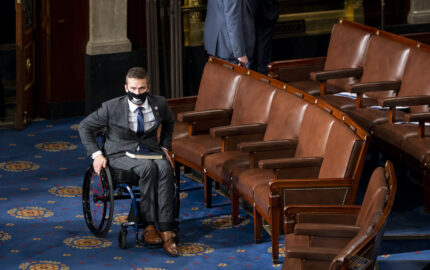I had barely settled in at The Washington Post when a white colleague came by to press the case for me joining the reporters' union. This was around 1976, after I'd come to the Post from The Minneapolis Star, where I had been hired through an arrangement the union had to bring minority journalists into newsrooms. Financial support of the union, I was told, was the least I could do. Without it, I would not have been hired at either place.
I responded in the spirit of the time. I owed my job, I said, not to a union deal, but to the race riots that swept the country a few years earlier. When the union goes on strike to make the newsroom 70 percent black—like the population of the District of Columbia—I'll support it, I replied.
My colleague and I were both right. The response to the riots set in motion a deliberate push by newspapers to hire minority journalists, and that got me hired at the Star and the Post.
Now, nearly half a century after rioters in Los Angeles shouted "Burn, baby, burn," the entire notion of newsroom diversity is up for grabs starting with what the words mean in the digitized and fragmented environment that is journalism today.
Journalists from my era understand the value gained by this decades-old strategy. Yet ours was a different day. The Kerner Commission's scathing appraisal of the news coverage of the 1967 race riots spurred diversity initiatives at newspapers across the country. That report landed in America's newsrooms with an ominous thud. Its attacks on the news media were rooted in the principles of our profession—perspective, credibility and standards. Here are a few excerpts from the commission's report:
That lone columnist was Carl T. Rowan. After diversity policies and a refreshing mindset fell into place, other blacks began to be hired as columnists (and reporters and editors); in time, many earned national renown.
A decade after the Kerner report, the American Society of Newspaper Editors, now known as the American Society of News Editors (ASNE), started to hold newsrooms accountable as it tracked diversity in an annual census. ASNE set a goal of staff parity with America's minority population by the year 2000, what seemed then a long march of 22 years. Two years from that target date and still thousands of journalists shy of its goal, ASNE gave itself a bit more time—like another quarter century—pushing its parity date to 2025.
When the ASNE census began, one of every 25 employees in newspaper newsrooms was a journalist of color, compared to one of every five U.S. residents. This year one of every eight such employees is a minority, while one of every three U.S. residents is a person of color. At a time when more than 90 percent of our nation's population growth in the last decade was among people of color, these diversity efforts are losing ground. And the content of news reporting is also not reflecting these changes. Last year the Pew Research Center for the People & the Press reported significant lingering discontent with the balance, accuracy and scope of news coverage of race and race relations—echoing concerns expressed by the Kerner Commission 42 years earlier.
Diversity fatigue has been alive and well in America's news industry for many years. Even before ASNE started to experience a steady decline in its membership, the diversity sessions at its annual convention were sparsely attended. In the minds of some people, diversity had gone far enough. They viewed it as an unaffordable luxury during a time of financial difficulties that signaled the need to hold on to high-value customers and newsroom employees, most of whom were white. In the eyes of many journalists of color—including Hispanics, Asians and Native Americans along with African Americans—the goals of diversity were unmet and the mission remained incomplete.
Shoving diversity aside has left journalists of color with an unpleasant, even bitter taste. Many have come to believe that de facto, if not de jure, they are pigeonholed into doing certain kinds of stories, making certain kinds of arguments, covering certain beats, and thinking only, it seems, in certain ways. B.B. King's hit single sums it up:
Diversity Conversations
This year journalists are talking about these issues again in a two-part conference we're calling Leadership in Diversity: New Models for Growing Audience, Talent and Revenues. The first session happened in June in Orlando, Florida at Walt Disney World (coincidentally, but perhaps also fitting, given Disney's ownership of major broadcast entities and its acknowledged leadership in diversity). September's meeting is at The New York Times. Coordination and oversight of this effort resides in the hands and minds of an incredibly broad coalition of news industry representatives, with financial support coming from the ASNE, Ford, Gannett and McCormick foundations and the Philip L. Graham Fund.
Our mission in Orlando was to figure out ways to move the newsroom diversity argument away from being strictly about numbers and in the direction of content. Then the stage will be set for the dollars-and-cents, bottom-line argument about why reaching readers of color matters. Clearly, changing times call for different strategies, and as we were meeting to discuss them, change was in the air.
Orlando's hometown paper, the Sentinel, now has a black editor, but a new owner, too—and a less certain future. Meanwhile the National Association of Black Journalists (NABJ) had just opted out of Unity, which had been formed to bring minority journalists together. [NABJ is scheduled to begin discussions with Unity in mid-September about possible reunification.] The National Association of Hispanic Journalists that was holding its annual convention in Orlando was just about to let go most of its staff. ASNE, too, has cut its diversity program by more than half, and future efforts are uncertain.
Some of us at the June meeting wondered if this might be diversity's last hurrah. In the post-Kerner era, news organizations hired their way to diversity. Now, not much hiring is happening so training, retention and advancement become more important. Innovation and collaboration are key, too. And for a host of reasons, legacy newsrooms are no longer as attractive a destination as they once were for many of the smartest and most talented young persons of color. Even back then, however, television was shooting past newspapers as the news source of choice in the black communities of America. The Internet has now shoved newspapers into third place among most news consumers, and blacks and Latinos are using mobile phones at higher rates than whites.
The dominance of newspapers is fading or gone. They are less essential to broader clusters of readers, replaced by the trimmed down, sped up digital news. Yet communities of color still need and want journalism that holds governments, institutions and people accountable and provides insight and understanding on issues that reflect the totality of their lives. That's what we hope the entrepreneurial talent and mindset of the children and grandchildren of the post-Kerner era will produce.
When business executives join us at our New York meeting, conversations are likely to flow in the direction of meshing innovation and technological know-how with the goal of reaching readers of color with journalism of substance that matters in their lives. The economic imperative for doing so is one of the messages we'll deliver. Let's hope that in this time of digital sharing, it's a message that gets spread far and wide.
Milton Coleman is senior editor of The Washington Post, immediate past president of ASNE, and president-elect of the Inter American Press Association. He is a 1974 graduate of the Michele Clark Summer Program for Minority Journalists at Columbia University.
I responded in the spirit of the time. I owed my job, I said, not to a union deal, but to the race riots that swept the country a few years earlier. When the union goes on strike to make the newsroom 70 percent black—like the population of the District of Columbia—I'll support it, I replied.
My colleague and I were both right. The response to the riots set in motion a deliberate push by newspapers to hire minority journalists, and that got me hired at the Star and the Post.
Now, nearly half a century after rioters in Los Angeles shouted "Burn, baby, burn," the entire notion of newsroom diversity is up for grabs starting with what the words mean in the digitized and fragmented environment that is journalism today.
Journalists from my era understand the value gained by this decades-old strategy. Yet ours was a different day. The Kerner Commission's scathing appraisal of the news coverage of the 1967 race riots spurred diversity initiatives at newspapers across the country. That report landed in America's newsrooms with an ominous thud. Its attacks on the news media were rooted in the principles of our profession—perspective, credibility and standards. Here are a few excerpts from the commission's report:
- The media report and write from the standpoint of a white man's world.
- We suggest that the main failure of the media last summer was that the totality of its coverage [of the riots] was not as representative as it should have been to be accurate. We believe that to live up to their own professed standards, the media simply must exercise a higher degree of care and a greater level of sophistication than they have shown in this area—higher, perhaps, than the level ordinarily acceptable with other stories.
- Fewer than 5 percent of the people employed by the news business in editorial jobs in the United States today are Negroes. Fewer than 1 percent of editors and supervisors are Negroes, and most of them work for Negro-owned organizations.
- The plaint is, 'We can't find qualified Negroes.' But this rings hollow from an industry where, only yesterday, jobs were scarce and promotion unthinkable for a man whose skin was black. Even today, there are virtually no Negroes in positions of editorial or executive responsibility and there is only one Negro newsman with a nationally syndicated column.
That lone columnist was Carl T. Rowan. After diversity policies and a refreshing mindset fell into place, other blacks began to be hired as columnists (and reporters and editors); in time, many earned national renown.
A decade after the Kerner report, the American Society of Newspaper Editors, now known as the American Society of News Editors (ASNE), started to hold newsrooms accountable as it tracked diversity in an annual census. ASNE set a goal of staff parity with America's minority population by the year 2000, what seemed then a long march of 22 years. Two years from that target date and still thousands of journalists shy of its goal, ASNE gave itself a bit more time—like another quarter century—pushing its parity date to 2025.
When the ASNE census began, one of every 25 employees in newspaper newsrooms was a journalist of color, compared to one of every five U.S. residents. This year one of every eight such employees is a minority, while one of every three U.S. residents is a person of color. At a time when more than 90 percent of our nation's population growth in the last decade was among people of color, these diversity efforts are losing ground. And the content of news reporting is also not reflecting these changes. Last year the Pew Research Center for the People & the Press reported significant lingering discontent with the balance, accuracy and scope of news coverage of race and race relations—echoing concerns expressed by the Kerner Commission 42 years earlier.
Diversity fatigue has been alive and well in America's news industry for many years. Even before ASNE started to experience a steady decline in its membership, the diversity sessions at its annual convention were sparsely attended. In the minds of some people, diversity had gone far enough. They viewed it as an unaffordable luxury during a time of financial difficulties that signaled the need to hold on to high-value customers and newsroom employees, most of whom were white. In the eyes of many journalists of color—including Hispanics, Asians and Native Americans along with African Americans—the goals of diversity were unmet and the mission remained incomplete.
Shoving diversity aside has left journalists of color with an unpleasant, even bitter taste. Many have come to believe that de facto, if not de jure, they are pigeonholed into doing certain kinds of stories, making certain kinds of arguments, covering certain beats, and thinking only, it seems, in certain ways. B.B. King's hit single sums it up:
"The thrill is gone; the thrill is gone away.
The thrill is gone, baby. The thrill is gone away …"
Diversity Conversations
This year journalists are talking about these issues again in a two-part conference we're calling Leadership in Diversity: New Models for Growing Audience, Talent and Revenues. The first session happened in June in Orlando, Florida at Walt Disney World (coincidentally, but perhaps also fitting, given Disney's ownership of major broadcast entities and its acknowledged leadership in diversity). September's meeting is at The New York Times. Coordination and oversight of this effort resides in the hands and minds of an incredibly broad coalition of news industry representatives, with financial support coming from the ASNE, Ford, Gannett and McCormick foundations and the Philip L. Graham Fund.
Our mission in Orlando was to figure out ways to move the newsroom diversity argument away from being strictly about numbers and in the direction of content. Then the stage will be set for the dollars-and-cents, bottom-line argument about why reaching readers of color matters. Clearly, changing times call for different strategies, and as we were meeting to discuss them, change was in the air.
Orlando's hometown paper, the Sentinel, now has a black editor, but a new owner, too—and a less certain future. Meanwhile the National Association of Black Journalists (NABJ) had just opted out of Unity, which had been formed to bring minority journalists together. [NABJ is scheduled to begin discussions with Unity in mid-September about possible reunification.] The National Association of Hispanic Journalists that was holding its annual convention in Orlando was just about to let go most of its staff. ASNE, too, has cut its diversity program by more than half, and future efforts are uncertain.
Some of us at the June meeting wondered if this might be diversity's last hurrah. In the post-Kerner era, news organizations hired their way to diversity. Now, not much hiring is happening so training, retention and advancement become more important. Innovation and collaboration are key, too. And for a host of reasons, legacy newsrooms are no longer as attractive a destination as they once were for many of the smartest and most talented young persons of color. Even back then, however, television was shooting past newspapers as the news source of choice in the black communities of America. The Internet has now shoved newspapers into third place among most news consumers, and blacks and Latinos are using mobile phones at higher rates than whites.
The dominance of newspapers is fading or gone. They are less essential to broader clusters of readers, replaced by the trimmed down, sped up digital news. Yet communities of color still need and want journalism that holds governments, institutions and people accountable and provides insight and understanding on issues that reflect the totality of their lives. That's what we hope the entrepreneurial talent and mindset of the children and grandchildren of the post-Kerner era will produce.
When business executives join us at our New York meeting, conversations are likely to flow in the direction of meshing innovation and technological know-how with the goal of reaching readers of color with journalism of substance that matters in their lives. The economic imperative for doing so is one of the messages we'll deliver. Let's hope that in this time of digital sharing, it's a message that gets spread far and wide.
Milton Coleman is senior editor of The Washington Post, immediate past president of ASNE, and president-elect of the Inter American Press Association. He is a 1974 graduate of the Michele Clark Summer Program for Minority Journalists at Columbia University.



